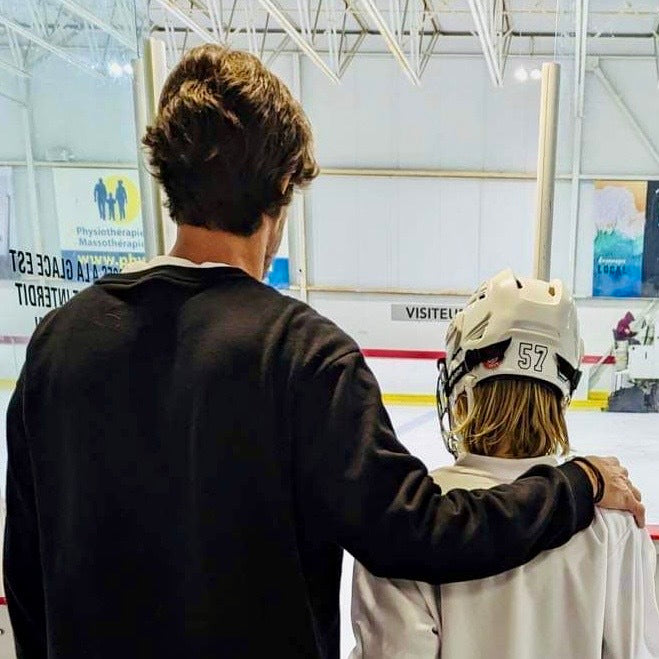BACK TO HOCKEY EQUIPMENT CHECKLIST
Preparing for another hockey year involves several essential steps for players and their families. Here's a comprehensive back-to-hockey checklist with crucial reminders for both minor and competitive hockey players.
The first step is to review the player's gear from the previous season to ensure a proper fit and adequate protection. It's essential to thoroughly inspect all equipment, including straps, elastics, and helmet padding, to assess their condition. If any rust is found on the cage of the hockey helmet, it's crucial to replace it promptly to maintain structural integrity.
For the skates, players should verify if they still fit properly and examine the sharpness of the blades. Consider getting the skates sharpened for optimal performance. Additionally, players should inspect their gloves to ensure that both the palms and fingers are in good shape. Using gloves with holes can pose a significant risk of severe injuries, such as broken fingers. Taking the time to inspect and maintain the gear is paramount for the player's safety and overall performance on the ice.
By ensuring that the hockey equipment is in top condition, young hockey players can embark on a new season with confidence and excitement.

Here's a list of hockey equipment and accessories you will need for a joyful and hassle-free season:
You will find a helpful printable checklist below this article for an easier back-to-hockey shopping spree.
GOOD QUALITY AND BREATHABLE 1ST LAYERS (UNDERWEAR) AND SOCKS: Your first layers are crucial as they are in direct contact with your body. It's essential to ensure they are breathable, comfortable, and properly fitted to avoid bunching up under your equipment.
TOPS: Some tops come with the added benefit of an integrated neck guard, making them an excellent choice for added protection (neck guards are mandatory). You can choose between long sleeves or short sleeves based on your preference. Alternatively, there are regular shirts made from suitable fabrics, providing you with options tailored to your needs.
BOTTOMS: Some pants or shorts come equipped with a protective cup and Velcro tabs for your hockey socks, which is very useful as it eliminates the need to buy them separately. However, if you prefer to have them as separate pieces, that option is also available.
JOCK: If your bottom doesn't have an integrated cup, it's essential to purchase a separate jock strap. Make sure to get the right size for your child, whether it's junior or senior.
NON-COTTON SKATE SOCKS: We often see many people playing with cotton socks in their skates, but this can be a bad idea as they don't wick away moisture effectively. Fortunately, there are plenty of different choices available, made with proper fabrics, to address this issue. From thin to thick, mid-length to tall length, and even anti-cut options, you can find socks that provide the necessary protection, fit perfectly in your skates, and keep your feet dry.
PROPERLY FITTED SKATES: Ensuring you have skates that fit just right is crucial – not too small, not too big. A properly fitted skate not only enhances your skating ability but also prevents foot pain throughout the year. Remember, both your skates and your helmet are the two most important pieces of equipment in your bag, so make sure they're the right ones for you.
SHIN GUARDS: The length of your shin guards will vary based on how you place them on your legs. If you play with the tongues "in," meaning the pads go over your skate's tongues, you will need slightly longer shin pads (2 fingers over the ankle bone once the kneecap of the pad is in the right spot). On the other hand, if you play with the tongues "out," placing your pad underneath your skate's tongues, you will need shorter ones (3 fingers over your ankle bone once the kneecap of the pad is in the right spot).
HOCKEY PANTS: When it comes to hockey pants, you have two main options: the classic hockey pant or a girdle and shell combo. The advantage of the girdle and shell combo is the ability to change your pants' color simply by switching the shell. Some hockey associations even provide shells in their team colors for players. Both options are excellent; it ultimately depends on personal preference. To ensure proper sizing, the pants should sit comfortably on the hips without overtightening the belt strap. They should also extend down to the middle of the kneecap when standing straight. For taller and skinnier kids, adding suspenders can help achieve a better fit and ensure the pants stay in place during play.
SHOULDER PADS: The level of play should determine the level of protection needed for your shoulder pads. For non-contact play, you can opt for a slimmer and more lightweight model that still gets the job done if the fit is right. Make sure the back and front portions of the shoulder pads sit slightly inside the top of your pants or as close as possible. Additionally, there should be no gap between the bottom of the arm protection and your elbow pad.
ELBOW PADS: It's crucial to prevent your elbow pads from slipping while you play. Ensuring they stay in place is essential for your comfort and safety, especially during falls. When choosing the right size, make sure there is no gap between your shoulder pads and the elbow pads. The elbow pads should extend down your forearm, very close to your gloves' cuff, and the padding on top should cover your forearm adequately. If the strap is too short, it indicates that the size isn't right for you.
NECK GUARD: In Canada, a certified neck guard is mandatory for playing hockey. Fortunately, there are various models available, so you can choose the one that suits your preference. If you already have a top with an integrated neck guard, you're all set, and there's no need to buy another one.
HELMET AND CAGE OR FULL VISOR (FISHBOWL): As mentioned earlier, a comfortable and properly fitting helmet is crucial for safety. It should stay securely on your head without any movement or pressure points. Additionally, the cage or visor must be well-adjusted. Ensure the chin guard is in the correct position, and the J-clips on the sides of the helmet are aligned to prevent the cage from hitting your face.
GLOVES: To ensure more control and protection, it's essential to have gloves that fit properly. A helpful trick to determine if they are the right size is to be able to easily pick up your stick when it's flat on the ground. As for the glove style, it all comes down to personal preference.
HOCKEY STICK: When choosing a hockey stick, it's crucial to determine if your kid is left-handed or right-handed. For guidance on the blade pattern (curve) or flex that is recommended, don't hesitate to seek assistance from a salesclerk.
HOCKEY BAG: Having a big bag to store all your hockey gear is essential. Some bags come with wheels, making it easier for younger and smaller players to carry their equipment.
PRACTICE HOCKEY SOCKS AND JERSEY: Your kid will receive a jersey and socks from the association they play in for games. However, for hockey camp and practices, they will generally need to have their own set of jerseys and socks.
*When it comes to the helmet, pants, and gloves, it's a good idea to validate your association's colors to ensure you buy the proper colors.
ACCESSORIES:
-
TAPE (CLOTH AND CLEAR) AND WAX: Cloth tape and wax for taping the sticks and clear tape to secure the shin guards.
PERSONAL WATER BOTTLE: Due to the Covid pandemic, associations now require individual players to bring their own water bottles to the rink. One advantage of this change is that players can fill their bottles with their preferred drinks, such as Biosteel or other beverages.
SKATE GUARDS: Using skate guards is highly preferable as they prevent damage to your runners when walking around with your skates and also protect your equipment from cuts in the bag. Remember to remove the guards from your blades when taking your equipment out for drying.
SKATE MAT: Don't suffer from wet feet when removing your winter boots or skates. Additionally, considering the less-than-ideal cleanliness of locker room floors, a small skate rug can be a game-changer.
2ND SET OF RUNNERS: If your kid spends a lot of time on the ice, consider investing in a second pair of runners. This can save both money and time with sharpening. Moreover, having two different sharpening (hollows) allows for better performance on varying ice conditions, whether playing on harder or softer ice or outdoor rinks. Thanks to modern holder technologies, changing runners takes about 30 seconds.
EXTRA SET OF LACES: Breaking your laces while tying your skate is something that can happen to anyone at some point. That's why it's always a good idea to have an extra set of laces on hand, especially when it occurs right before you're about to step onto the ice.
-
MINI SCREWDRIVER AND SCISSORS: A mini screwdriver is always handy for quick helmet repairs. Keep scissors available to easily cut the tape or laces if you encounter a big knot.
-
SMALL CARRY BAG TO PUT IN YOUR MAIN HOCKEY BAG: Similar to a cosmetic bag, this small bag is perfect for storing your tape, hockey wax, mini screwdriver, and extra laces in your main hockey bag. With everything organized in one place, you won't have to search everywhere to find your small accessories.
SHOWER GEL, FLIP FLOPS, AND TOWEL: If your kid plans on taking a shower at the rink, make sure they have all these items.
You can save and/or print the image below to make sure you don't forget anything when doing your back-to-hockey shopping. Available in english and french.




